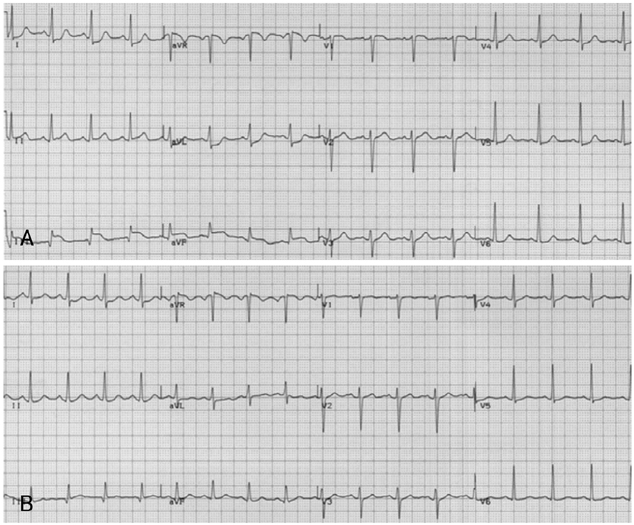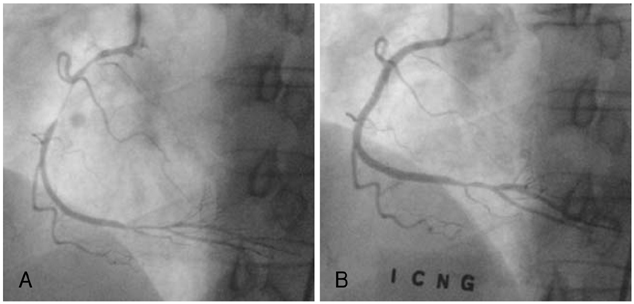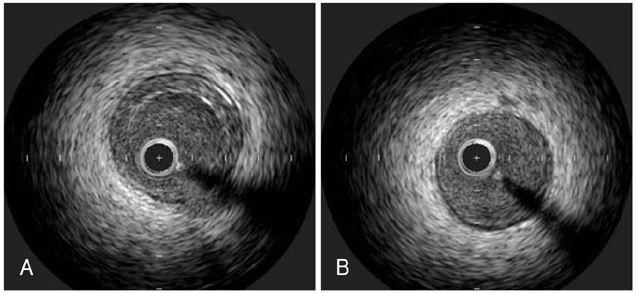Korean Circ J.
2008 Jan;38(1):66-68. 10.4070/kcj.2008.38.1.66.
Reversed Circadian Variation in Variant Angina
- Affiliations
-
- 1Division of Cardiology, Department of Internal Medicine, Seoul National University College of Medicine, Seoul, Korea. hyosoo@snu.ac.kr
- KMID: 2225876
- DOI: http://doi.org/10.4070/kcj.2008.38.1.66
Abstract
- It is known that there is a marked variation in the frequency of variant angina attacks according to the circadian rhythm. The attack frequency is usually highest in the early morning and lowest in the afternoon. We describe here a middle-aged woman with variant angina whose chest pain occurred only during daytime. Because of her job, she sleeps from noon to 6 pm, and she experienced chest pain only during 2 to 3 pm. These findings suggest that the alterations to the sleep and wake cycle can affect the circadian variation of variant angina.
Keyword
MeSH Terms
Figure
Reference
-
1. Yasue H, Omote S, Takizawa A, Nagao M, Miwa K, Tanaka S. Circadian variation of exercise capacity in patients with Prinzmetal variant angina: role of exercise-induced coronary arterial spasm. Circulation. 1979. 59:938–948.2. Waters DD, Miller DD, Bouchard A, Bosch S, Theroux P. Circadian variation in variant angina. Am J Cardiol. 1984. 54:61–64.3. Araki H, Koiwaya Y, Nakagaki O, Nakamura M. Diurnal distribution of ST segment elevation and related arrhythmias in patients with variant angina: a study by ambulatory ECG monitoring. Circulation. 1983. 67:995–1000.4. Park YB, Lee YW. Coronary artery spasm in patients with coronary artery disease. Korean Circ J. 1988. 18:161–176.5. Ogawa H, Yasue H, Oshima S, Okumura K, Matsuyama K, Obata K. Circadian variation of plasma fibrinopeptide A level in patients with variant angina. Circulation. 1989. 80:1617–1626.6. Takusagawa M, Komori S, Umetani K, et al. Alterations of autonomic nervous activity in recurrence of variant angina. Heart. 1999. 82:75–81.7. Otsuka K, Yanaga T, Watanabe H. Variant angina and REM sleep. Am Heart J. 1988. 115:1343–1346.8. Yamagishi M, Miyatake K, Tamai J, Nakatani S, Koyama J, Nissen SE. Intravascular ultrasound detection of atherosclerosis at the site of focal vasospasm in angiographically normal or minimally narrowed coronary segments. J Am Coll Cardiol. 1994. 23:352–357.9. MacAlpin RN. Relation of coronary arterial spasm to sites of organic stenosis. Am J Cardiol. 1980. 46:143–153.
- Full Text Links
- Actions
-
Cited
- CITED
-
- Close
- Share
- Similar articles
-
- Circadian Variation of Transient Myocardial Ischemia
- Long-term Circadian Patterns of Angina Attacks and Non-pharmacological Provocation Tests Responses in Patients with Vasospastic Angina
- A case of complete atrioventricular block persisting for 5 days in a patient with variant angina
- Circadian variation of exercise test response and diagnostic significance of non-pharmacological provocation tests in patients with vasospastic angina
- A Case of Refractory Variant Angina Relieved by Clonidine




